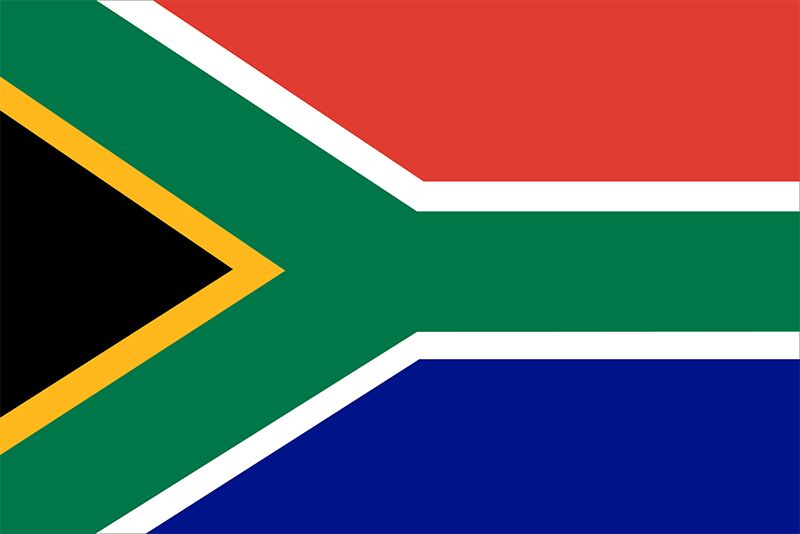
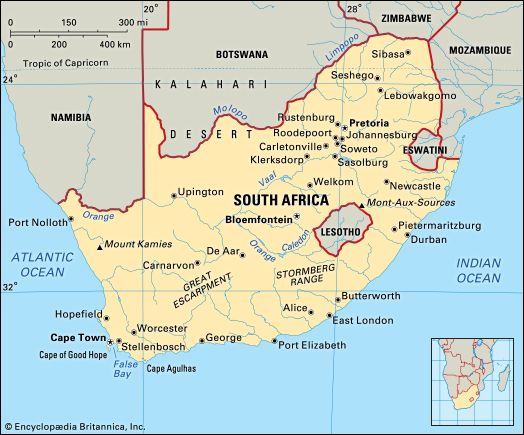 National anthem of South AfricaSouth Africa is the southernmost country on the continent of Africa. It has three capital cities: Pretoria (Tshwane), Cape Town, and Bloemfontein. They each are home to a different branch of the government.
National anthem of South AfricaSouth Africa is the southernmost country on the continent of Africa. It has three capital cities: Pretoria (Tshwane), Cape Town, and Bloemfontein. They each are home to a different branch of the government.
The land that is now South Africa was home to some of the earliest human ancestors. Over many centuries people from other parts of Africa moved into the area, and, eventually, Europeans arrived. As a result, the country is very diverse today. Although it has a long history, the current country has existed only since 1910.
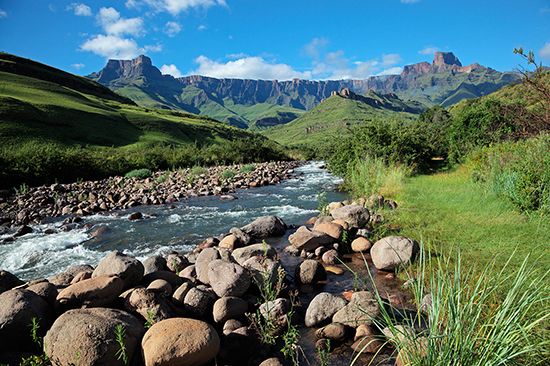
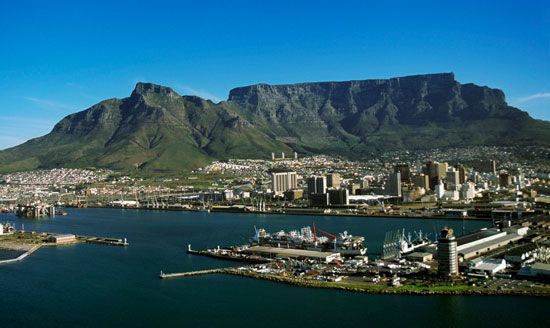
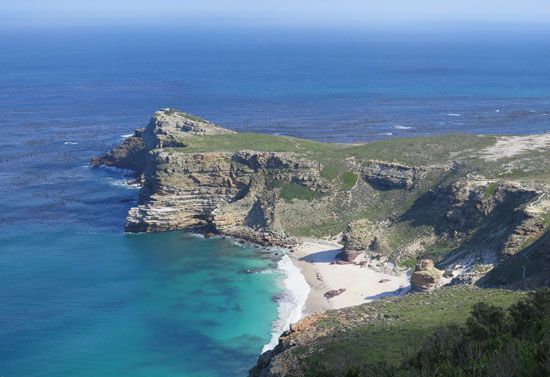 South Africa has a long coastline on the Atlantic and Indian oceans. To the north, South Africa borders Namibia, Botswana, Zimbabwe, Mozambique, and Eswatini (formerly Swaziland). South Africa surrounds the tiny kingdom of Lesotho.
South Africa has a long coastline on the Atlantic and Indian oceans. To the north, South Africa borders Namibia, Botswana, Zimbabwe, Mozambique, and Eswatini (formerly Swaziland). South Africa surrounds the tiny kingdom of Lesotho.
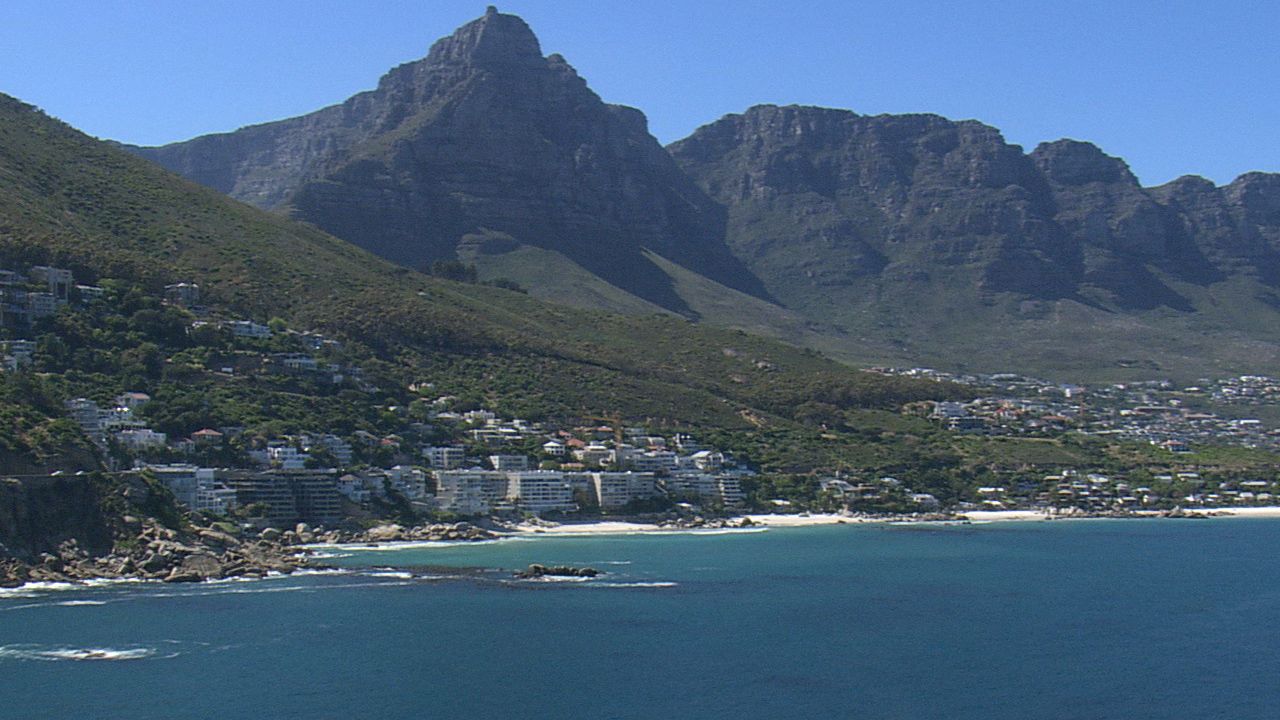 Most of South Africa is a plateau, or raised flat area. Mountains separate the high plateau from lower plains along the coast. The highest mountain range is the Drakensberg, in the east. The Kalahari and Namib deserts cover parts of the west. The main rivers in South Africa are the Orange and the Limpopo.
Most of South Africa is a plateau, or raised flat area. Mountains separate the high plateau from lower plains along the coast. The highest mountain range is the Drakensberg, in the east. The Kalahari and Namib deserts cover parts of the west. The main rivers in South Africa are the Orange and the Limpopo.
Most of South Africa has a dry climate with warm summers and cool winters. Drought is a common problem.
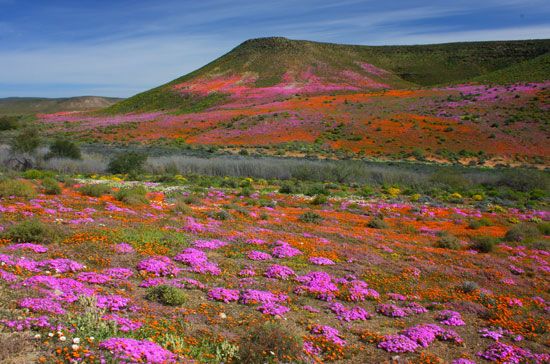 Grasslands with scattered trees cover much of South Africa. Many types of flowering plants grow in the southwest. The dry parts of the west have shrubs and bushes that can survive with little rain. South Africa’s few forests grow in mountain valleys and along stretches of the coast.
Grasslands with scattered trees cover much of South Africa. Many types of flowering plants grow in the southwest. The dry parts of the west have shrubs and bushes that can survive with little rain. South Africa’s few forests grow in mountain valleys and along stretches of the coast.
South Africa has limited numbers of lions, elephants, rhinoceroses, hippopotamuses, and antelope. The country’s large animals live mainly in wildlife parks.
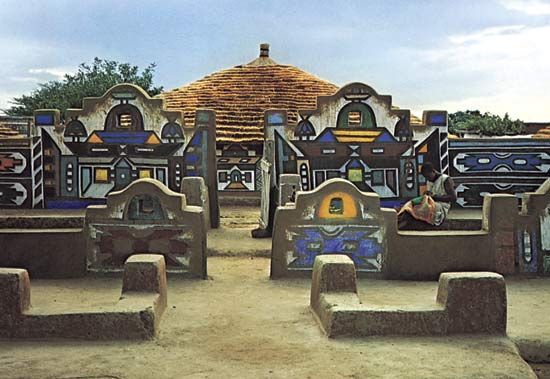
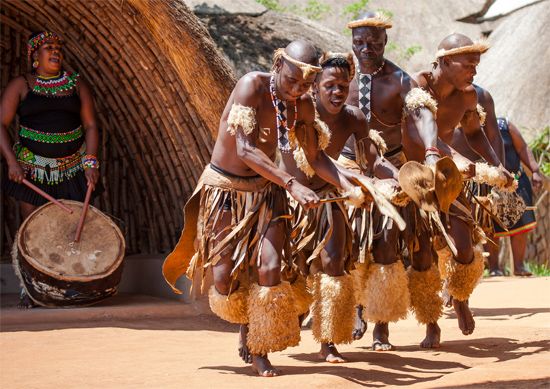 Black Africans make up about 80 percent of South Africa’s population. They belong to a number of groups, including the Zulu, the Xhosa, and the Ndebele. Each of the African groups has its own language.
Black Africans make up about 80 percent of South Africa’s population. They belong to a number of groups, including the Zulu, the Xhosa, and the Ndebele. Each of the African groups has its own language.

 South Africa has three main minority groups: people of European descent, people of mixed ancestry, and people of Asian descent. The people of European descent speak either Afrikaans (a language related to Dutch) or English. The Afrikaners (those who speak Afrikaans) have mainly Dutch, French, and German roots. The English speakers have mainly British ancestors. The people of mixed descent have African, Asian, and European roots. The ancestors of the people of Asian descent came mainly from India.
South Africa has three main minority groups: people of European descent, people of mixed ancestry, and people of Asian descent. The people of European descent speak either Afrikaans (a language related to Dutch) or English. The Afrikaners (those who speak Afrikaans) have mainly Dutch, French, and German roots. The English speakers have mainly British ancestors. The people of mixed descent have African, Asian, and European roots. The ancestors of the people of Asian descent came mainly from India.
Most South Africans are Christians. More than half of the people live in cities, mainly in the east. The major urban areas are Johannesburg, Cape Town, Durban, and Pretoria.
Services such as banking and tourism are key parts of South Africa’s economy. People come to South Africa to see the country’s great natural beauty and to learn about its diverse culture. The country has several national parks, including Kruger and Garden Route. National botanical parks, such as Kirstenbosch, dot the country.
Mining and manufacturing are also very important. South Africa is a top producer of many minerals, including gold, platinum, and chromium. It also mines coal and diamonds. Factories make iron and steel, food products, machinery, chemicals, cars, and other goods.
South Africa’s major crops include corn, wheat, sugarcane, citrus fruits, and potatoes. Farmers also grow grapes to make wine. Meat, wool, and milk are other important farm products.
Scientists have found stone tools used by early human ancestors at many sites in South Africa. They date from more than a million years ago. There is other evidence of early humans, including rock paintings that were made thousands of years ago. Some of those were from the San and the Khoekhoe peoples, who roamed southern Africa about 10,000 years ago. About 2,000 years ago peoples who spoke Bantu languages settled in the region. The Bantu peoples were the ancestors of most of the Black people in South Africa today.
At some point the people in the area began to build organized communities. The area was home to the kingdom of Mapungubwe and later Thulamela.
European Settlement
The Portuguese sailed around the southern tip of Africa in the late 1400s. In 1652 the Dutch set up a colony on the southwest coast. They slowly expanded their settlements, planted crops, and raised livestock. They became known as Boers, meaning “farmers.” (Later they became known as Afrikaners.) As the Boers moved east, they fought with many African peoples, especially the Xhosa. In the 1780s the two groups began to fight over land and cattle. The struggle lasted for a century, but eventually the Boers defeated the Xhosa. The Boers added Xhosa lands to their colony. This series of conflicts is known as the Cape Frontier Wars.
By 1806 the British had taken over the Dutch settlement. To escape British rule, many Boers moved north during the 1830s and 1840s. Their move is known as the Great Trek. Along the way the Boers fought with a number of African peoples. In the 1850s the Boers set up two states in the northeast: the South African Republic (or Transvaal) and the Orange Free State.
British Rule
In the late 1800s gold and diamonds were found in southern Africa. The British expanded their territory, called the Cape Colony, across the southern tip of Africa. They then tried to take over the Boer states. From 1899 to 1902 the British and the Boers fought the South African War. After winning the war, the British made the Boer states into British colonies.
 In 1910 all the British colonies in southern Africa united. They formed a new, independent country called the Union of South Africa.
In 1910 all the British colonies in southern Africa united. They formed a new, independent country called the Union of South Africa.
Apartheid
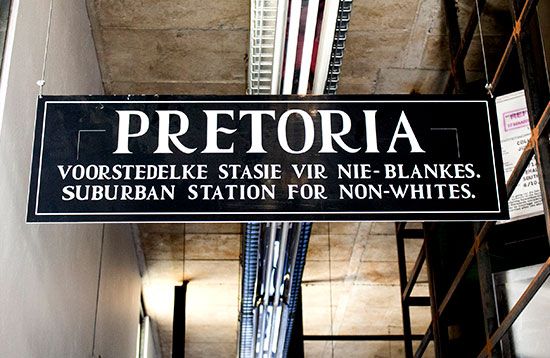 White people controlled the new government of South Africa. They passed laws that separated the population by race. This system of separation became known as apartheid. The word means “separateness” in the Afrikaans language. The system also gave the white minority nearly all the political power, most of the land, and the best jobs.
White people controlled the new government of South Africa. They passed laws that separated the population by race. This system of separation became known as apartheid. The word means “separateness” in the Afrikaans language. The system also gave the white minority nearly all the political power, most of the land, and the best jobs.
In 1912, Black people and people of mixed ancestry formed a political group that became known as the African National Congress (ANC). The ANC held nonviolent protests against the white government. In 1960 police shot hundreds of protesters in Sharpeville, South Africa. In response, the ANC turned to bombings and other acts of violence to protest apartheid. Some ANC leaders, including Nelson Mandela, went to jail.
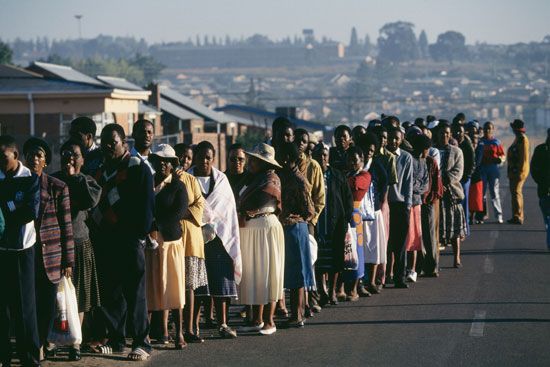
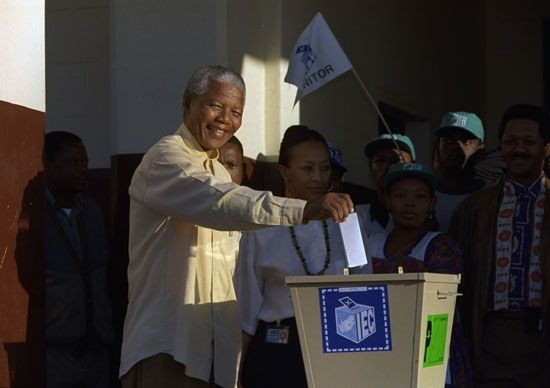 The apartheid system was widely condemned outside South Africa as well as within the country. In 1990 a new South African president, F.W. de Klerk, announced that apartheid would end. The government released Mandela from prison and threw out the apartheid laws. South Africans of all races voted in elections in 1994. Mandela became the country’s first Black president.
The apartheid system was widely condemned outside South Africa as well as within the country. In 1990 a new South African president, F.W. de Klerk, announced that apartheid would end. The government released Mandela from prison and threw out the apartheid laws. South Africans of all races voted in elections in 1994. Mandela became the country’s first Black president.
A New South Africa
 Mandela’s government had to deal with the long-term effects of apartheid. The government was especially concerned with helping the people who had been mistreated under the old laws. Its priorities included improving education, housing, health care, and wages among the nonwhite population. The country adopted a new constitution in 1996. The government also created a body known as the Truth and Reconciliation Commission. The commission investigated human-rights abuses committed during the apartheid era by both the South African government and the resistance movement. It was led by Archbishop Desmond Tutu.
Mandela’s government had to deal with the long-term effects of apartheid. The government was especially concerned with helping the people who had been mistreated under the old laws. Its priorities included improving education, housing, health care, and wages among the nonwhite population. The country adopted a new constitution in 1996. The government also created a body known as the Truth and Reconciliation Commission. The commission investigated human-rights abuses committed during the apartheid era by both the South African government and the resistance movement. It was led by Archbishop Desmond Tutu.
Thabo Mbeki of the ANC succeeded Mandela as president in 1999. Mbeki and later presidents faced many difficulties as the country continued to deal with problems of poverty and discrimination. The ANC remained the leading party in South Africa for 30 years. However, that changed in 2024. In the national elections that year the party received only 40 percent of the vote. For the first time the ANC had to form a government with another party.




